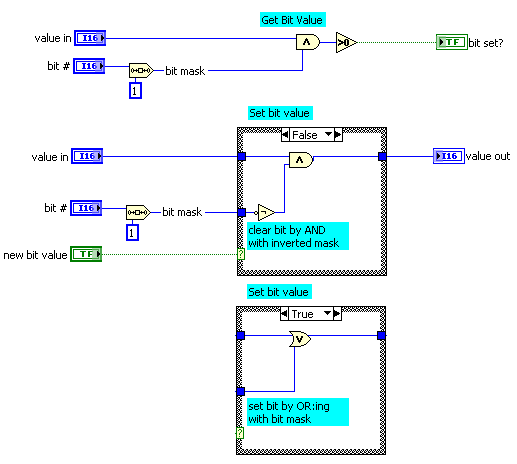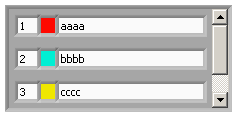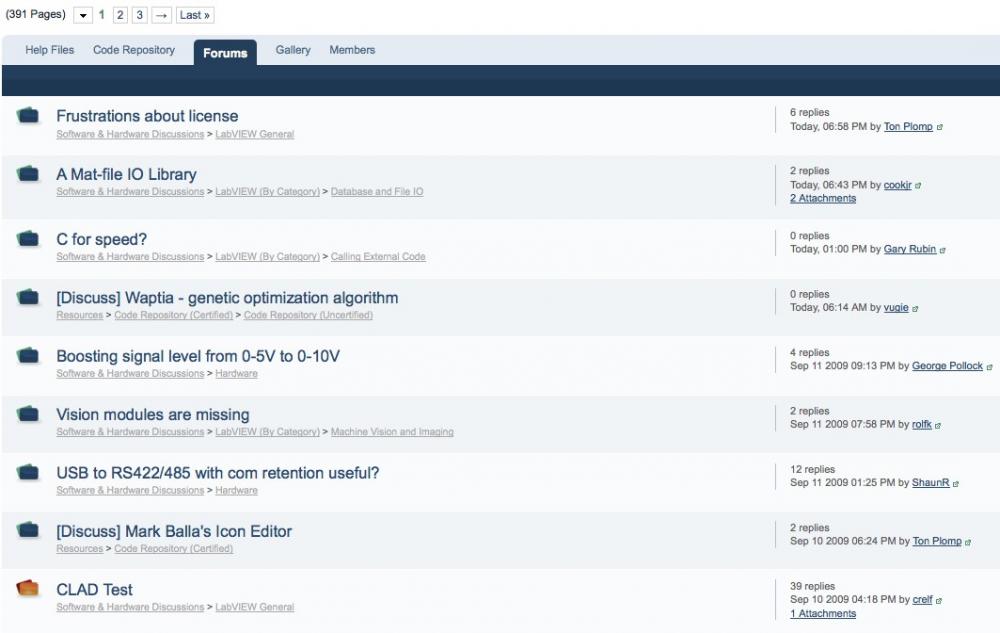
Mellroth
-
Posts
602 -
Joined
-
Last visited
-
Days Won
16
Content Type
Profiles
Forums
Downloads
Gallery
Posts posted by Mellroth
-
-
What you want to do for something like this is change the hierarchy which owns the reference. One way of doing this is to make sure the LV2 global is first loaded in a hierarchy which remains in memory (e.g. by having your main VI call it first). Another is to move the reference generation to a daemon which runs continuously and stays in memory. The daemon can accept requests using mechanisms like queues or user events.
Why not just add a Create method (for the reference type you want to create) to the LV2 global, instead of the Add Reference (or whatever it may be called).
/J
-
Posting bugs anywhere and not linking to the bug thread is a lot like writting poetry on the Men's room wall.
Quote of the day

I think I'll print that and put it in the Men's room...
/J
-
Thanks
 .
.You're welcome
/J
-
Is there a simple way to just import the settings from my previous version?
You can try to copy the labview.ini file from the old version and drop that in the new installation.
Some tokens are probably new, but the ones that are the same should use your old settings.
/J
-
Here are my approaches to bit twidding.
Dan
I think the middle picture is wrong, should be using an OR operation instead.
Here is another way of doing the bit manipulation
/J
-
Sorry, to correct my grammer...
No need to correct your grammar (but probably mine
 )
)I just meant that there might be a difference in LV8.5 and 8.6, that prevents the 0 pixel version from working in LV8.6 and higher.
/J
-
Of course this is what I did when I said I could not see any difference.
It all looks the same to me
My eye maybe out tho??

Can it be that the hack is no longer working in LV 8.6 and higher?
(I think the original was made in LV8.5)
/J
-
I have not found this borderless cluster..., can someone also repost this ctl?
I checked all my backups, but no luck.
Let's hope AQ can repost his hack.
/J
-
...when you right click mouse you could select custom probe two items "1 new;2 controls".
I can not find the right probe that I need.
would you tell me why, thanks!...
Hi
Could you please specify for what type of data you are creating a custom probe, and if possible, include the custom probe itself.
Can it be that you are trying to create a custom probe for a LVclass?
/J
-
Did anyone found any new way to overcome it? I have 8.2 - maybe in newer versions anything has changed at this field?
What could be an alternative way to get listbox-like behavior without element gaps?
I want to get sth like this (without these gaps):
(it is just a sketch - I know that I can remove frame from individual controls, clip them a little, etc. - but still 8 px gap cannot be removed)
This has been asked for before and thanks to Aristos Queue we have a solution (only on LAVA
 ).
).http://lavag.org/top...dpost__p__28056
/J
-
 1
1
-
-
URL isn't quite right in the link. Here's the fixed link:
Hmm, fixed you say

Seems like a bug, that inserts <B></B> directly after the "exp", even when you add an explicit link.
/J
-
How do i reconfigure the express VI? Need the program in a few weeks. not enough time to learn.
Saara:
I think you need these steps to complete it.
1. right click express VI
2. select "open front panel"
3.push the dialog "Convert"
4.now , you could read the source code and configure any item that you want
I actually think Ton meant not to convert the Express VI, but instead you should configure the express VI by right click, select Properties.
This will take you to the DAQ assistant, where you can add/remove channels as you want.
I have not checked your code, but if it is already converted to DAQmx code, you will have to restart by adding the DAQ Assistant Express VI from the Express->Input palette.
Then configure the channels as needed.
/J
-
The voip application that I am interested in is either a h323 or SIP based voip application. I've tried to lookup the codecs at ITU-T with no luck. Are these codecs usable in regular LabVIEW running in a Linux OS? What programming language did you use for these codecs in Linux?
I would quess that the codecs and the entire h323 setup on the Linux machine was probably all in C, with no LabVIEW involved in that part. Maybe it was compiled as shared library and accessed over the Call Library Node, or it could have been its own process and communicate over some TCP/IP protocol with the LabVIEW test application.
I'm sorry I haven't answered earlier, but this thread have not showed up in my unread content.
Rolf is pretty close in his assumptions; we had DLL's written in C to encode/decode on a windows target, and we implemented a proprietary protocol between the Windows host and the Linux server (running on a PC104) to send/receive the RTP traffic.
This way the audio communication was pretty straight forward, much like file I/O, and we could still add any new codecs to our system without having to add new codecs to the Linux server.
I did a quick search on ITU-T and come up with the following links for the codecs
http://www.itu.int/r...3.1-200605-I/en
http://www.itu.int/r...729-200701-I/en
http://www.itu.int/r...191-200509-I/en (contains G711 codec as well)
/J
-
I also want to point out another link that you can also use which shows you everything chronologically regardless of view:
Thanks, I'll probably use this until the "View Unread Content" issues gets sorted out.
/J
-
Both yesterday and today it worked fine. I hope that means that whatever caused this has stopped. I will try to keep an eye open to see if it happens again.
I still get the same behaviour, e.g. I noticed new posts in this thread on the Forum start page, but when I checked Unread content the thread does not show up (see attached image).
A while back I actually switched to the other setting, because it seemed to catch more of the new post, but it is still not 100%.
Now I'm back with the setting proposed.
/J
-
Also, I've had a few people suggest that if one member of your private data control is a refnum then all of them should be refnums, so that everything in the object behaves like a reference. I'm not sure what I think of that, but I'll throw it out there for consideration.
I really like to be able to have both byRef and byValue within the same class.That way I can have a number of high speed access members, and still beable to use ByRef on data that need it. So please don't force peopleinto selecting one type or the other.
/J
-
Over the past 24 hours or so there seems to be an issue with the View Unread Content page where it doesn't show threads I replied in.
To be more specific, it seems to be threads I'm subscribed to - I replied to the Alfa thread, but I'm not subscribed to it, because my last reply was in the LAVA 1.0 days, and that thread did appear in the list. The others, however, did not appear in the list. I knew about them because I got the emails and they do appear as unread in the Active Content page. They just don't appear in the Unread Content page.
Note - this is different from the previous issues people had. I'm talking about content I haven't seen yet. It should appear and it worked fine before yesterday.
Same here.
I sometimes miss the LAVA 1.0 behavior, where my last post showed up at unread content, sort of a confirmation of my post.
/J
-
Does anyone know how to disable only one element in a tree view and still be able to select this line.
Hi,
You can catch the mouse-down event on the Tree control, and discard this event if a disabled element (row + column) was clicked.
/J
-
LV 2009 has had some significant changes made under the hood. I don't know the specific details, but my understanding was that it could cause decreased performance in some cases and that NI is expecting this to improve in future versions.
It was my understanding that the changes made to the compiler shouldn't have made things worse, but allow for more future optimizations.
Obviously I was wrong

The good part, however, is that the DVR outperforms the SEQ. It is therefore possible to tweak all instances where SEQs are used.
All Producer-Consumer patterns, using queues, will still be 30% slower.
Do you know of any other slowdown in LabVIEW 2009 to be aware of?
/J
-
Hi,
If you really want to go for the ini-file format, I recommend that you check the OpenG Variant Configuration File VIs.
These VIs let you read/write clusters directly to an ini-file.
Apart from the header, what kind of data are you dealing with?
/J
-
I'm just starting to play with LV2009, and tested the DVR against a Single Element Queue (SEQ).
Compared to a SEQ in LabVIEW 8.6.1 the DVR runs about 2 times faster, but if I compare the SEQ speed in LV 2009 against SEQ speed in LV 8.6.1 the speed has decreased. The access time in LV 2009 goes up ~30%.
After seeing this I also measured the time it takes to add 100 000 elements (I32 values) to a queue and then remove them. In LV8.6.1 this takes ~80ms, in LV2009 it takes ~105ms, which is pretty close to 30% increase in access time.
Have anyone else seen this, or any other decrease in performance?
/J
-
...Looking for any help regarding using LabVIEW to set up a VOIP communications interface setup...
Hi,
I'm not sure if you just want to create a proprietary VOIP application in LabVIEW, or if you want to create a h323 VOIP application?
Building a proprietary VOIP protocol could be done just as crelf suggested.
Back in 2001 we developed an IP phone test equipment, and at that time we didn't have access to LabVIEW-RT, so we went with a Linux implementation to handle the RTP communication (we also needed very low level access to the network interfaces). The codecs (g711, g723, g729ab) were downloaded from ITU-T, and just compiled for our target.
Today you can probably handle the RTP streams directly in LabVIEW-RT, but I would still use codecs downloaded from ITU-T, and not spend time developing my own set of codecs in LabVIEW.
/J
-
Hi aleks,
I would go for the second solution.
If you are streaming a lot of data and want that to be deterministic, you might also want to consider to write data to disk in chunks where the size is an multiple of the block size used by the hard drive. The reason is that LabVIEW RT does not cache data, so if you are not writing complete blocks, it first has to read data to be able to write to a block on disk.
/J
-
...If the output needed to be at a certain location for other build tools, you could write a VI to copy the files from the new location back to the old location...
Why couldn't LabVIEW itself use a temporary build location and then copy the build to the specified location?
Relying on users to put builds in a certain folder just because Windows/LabVIEW has a problem with long file paths, is not that nice.
The application might build just fine on my system, but not on my colleagues system, just because his name is X characters longer than mine.
A temporary build location, could also help when the build destination is within a SCC hierarchy, where some destination files are locked.
In LV <8.6, LabVIEW builds everything just fine, then it might complain that the files are write protected, and throws all build files away.
With a temporary location, LabVIEW could prompt the user to fix the destination problem, instead of throwing the build files in the trash
/J




Read an ".ini" file and create a certain icon, by using the information given in the ".ini" file.
in Application Design & Architecture
Posted
Do you really want to create the icon or just display the icon on the front panel? I'm guessing that it is enough to display the icons, so my answers is based on that.
There are a number of ways to display pictures in labview, it all depends on how you want the user to see the different items.
If you have predefined icons, you can use a picture control to display the pictures.
You can also display a set of custom icons in a listbox, multicolumn listbox or tree control (limited to 16 by16 pixels).
If you don't need too change the pictures at runtime, you can use the picture ring control to display the different pictures.
If it is enough to have static pictures on the FP, you can just copy-paste pictures from Windows directly on the FP
/J